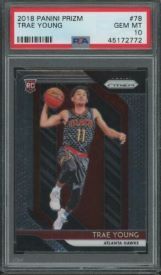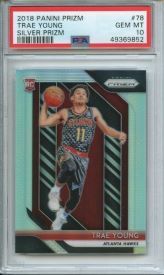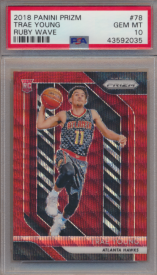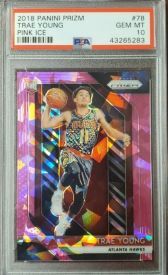Cardboard Calculus - A Week In Review
Card prices and population counts are not the only things in the hobby growing exponentially by the day. The amount of data being generated is astounding and much of it remains untapped. This is why I have created the Instagram account Cardboard.Calculus. Almost daily I uncover a new piece of information from the vast amount of data in the hobby and this is my platform to share it with the sports card world. In this series, I will take a look back at each week’s most interesting posts and provide further explanation for what I think it means for the hobby and our decision making when buying and selling cards.
Our pricing research is done using Sports Card Investor’s Market Movers data. You can sign up for your own Market Movers Subscription to access the data on your own and by using the promo code GRINDERS you will get 20% off your first payment on any subscription. You will want to sign up for Market Movers specifically in order to access the great tools and data, and if you sign up for the annual Market Movers subscription, you will save you 20% on the entire year instead of just the first month.
Cardboard Calculus – A Week In Review
Company Disclaimer: We may be compensated by the company links provided on this page
With this being the first article we have the benefit of looking back several weeks and pulling out the most interesting pieces of data I have uncovered on Cardboard Calculus. As of now, I have been entirely focused on PSA population data however that will not always be the case. As I add more and more data to my database the sky’s the limit. If you enjoy this type of content please feel free to give me a follow on Instagram to catch the visualizations from this article series and many more in real-time. Without further adieu, it is time to get into our first visualization.
Prizm Population Count By Year
This chart shows population counts for each year of Panini Prizm as of November 10th, 2020. I knew that Panini had been creating more and more product each year but the drastic increase took me by surprise. It is worth mentioning PSA population counts are not the same thing as print runs of a set but in theory it should be a pretty good indicator of relative supply. The population count for 2017 is over four times that of 2016. Some of this could be a stronger class of rookies in 2017 enticing more collectors and investors to send their cards in for grading. That being said it is hard to deny the clear message that from 2017 on we have seen growth accelerate in a big way.
As for how this will impact the hobby and our decision making it all comes down to supply and demand. Increased supply, even at astronomical levels like we have seen recently, is only a bad thing if there is not demand that will match it. Currently card prices are going up even for players in the 2017-2019 classes which indicates demand is currently up for the challenge. This chart however has confirmed one of the biggest risks to some of the big names in the recent draft classes. Population counts are only ever going up and the same cannot be said for demand. If and when demand does pull back higher population counts from PSA working through its backlog will put downward pressure on prices. Because of this, I prefer to buy raw for players in the 2018 class and later and have them graded myself or flip them as is. For players 2017 and earlier I am willing to buy graded or raw as long as I am getting my target price or below. There is less risk here both from lower population counts and more on-court performance for us to rely on.
Prizm Silver Base Ratios
Silver parallels have been a staple in the hobby for many years. Their popularity is driven both by their rarity and their beautiful shine. The problem is they are not as rare as they used to be. The chart gives a pretty good explanation of the metric I call Base Ratio, but put simply it is an estimation of how many base cards you will pull before pulling the given parallel. The biggest assumption here is that all parallels are submitted to PSA at the same rate which most certainly is not the case but regardless I think we are in the ballpark. If I was hunting for a silver Anthony Davis in 2012 I would need to pull on average 30 base Anthony Davis cards before getting my hands on the coveted prize. Flash forward to 2018 and I would need to pull only 5 Luka Base cards before unwrapping a silver of the hobby’s poster boy.
Silver truthers will tell you silver will always be king because of its history in the hobby and the unique reflective shine. I am here to challenge that notion. When I hear true hobbyists and collectors talk about the cards they own, or those that they wish to at some point, there is always an element of “the thrill of the chase”. A Lebron Topps Chrome refractor is not easy to come by as according to Market Movers there are less than 500 graded PSA 9 or better which is part of its allure. There are currently over 4,000 Luka Doncic 2018 Prizm silvers in a PSA 9 or better. I understand 4,000 is not a lot IF Luka becomes the next GOAT nominee but we also can’t ignore there are over 20,000 very similar alternatives known as his base card.
I do not say any of this to predict the end of good returns if you invest in silver prizms of the newest hot rookies. I say this because I believe other parallels will close the gap and potentially prove to be better investments in the long run as the market catches up to silver becoming a glorified base card. Parallels that are more rare but currently trading below silver prices are Green, Pink Ice, Ruby Wave, and Red Ice just to name a few. I wish I could tell you which, if any of these, will close the gap but I unfortunately do not have a crystal ball. If you think I am on to something though this would be a good list to get started doing your own research. The alternative approach if it fits your budget is to skip the lower end parallels all together and invest in numbered parallels with guaranteed rarity.
Trae Young Prizm Rookie Matrix
I want to close this week with something I call the Rookie Matrix. This chart allows us to compare a player’s different parallels within a set more easily. This chart when used with Market Movers pricing data can be a great way to pinpoint the parallels you want to target when investing in a player. In addition to population and Base Ratio metrics you will see that I have included the number of PSA 10s and the Gem Rate for each parallel. Gem Rate is the percentage of cards submitted of that parallel that received a grade of PSA 10.
| Sports Card | Description | Target Price |
 | Trae Young Panini Prizm PSA 10 | Target Under $600 |
 | Trae Young Prizm Silver PSA 10 | Target Under $2500 |
 | Trae Young Panini Prizm Ruby Wave PSA 10 | Target Under $1700 |
 | Trae Young Panini Prizm Pink Ice PSA 10 | Target Under $1700 |
Tying into our previous topic, Silver is far and away the most common parallel from a PSA population perspective. Some parallels like Green or Red, White, and Blue are not as sought after because they are retail only and are not the most aesthetically pleasing. Pink Ice though while a retail parallel, only available in Walmart Mega Boxes, is beautiful and considerably more rare than Silver. This is the type of parallel I like to target if they are trading at a discount to more plentiful parallels. The Gem Rate for Hypers also jumps off the page at me. At 11% it is 43% below average making it a very tough grade. Buying these raw to be graded would be a risky proposition and if you can find a PSA 10 at a fair price you can feel confident the population will not grow like other parallels.
As always you can sign up for your own Market Movers Subscription to access the data on your own and by using the promo code GRINDERS you will get 20% off your first payment on any subscription.
Conclusion
The above is just the tip of the iceberg when it comes to data in the hobby. As the hobby picks up more momentum we will have even more platforms that will generate data by the minute. It is my hope that in this series we will uncover some things that will change the way we see and understand the market as well as make us better collectors and investors alike. Hope you enjoyed this article and let me know in the comments what you think!


